
Spice up Your Home Landscape
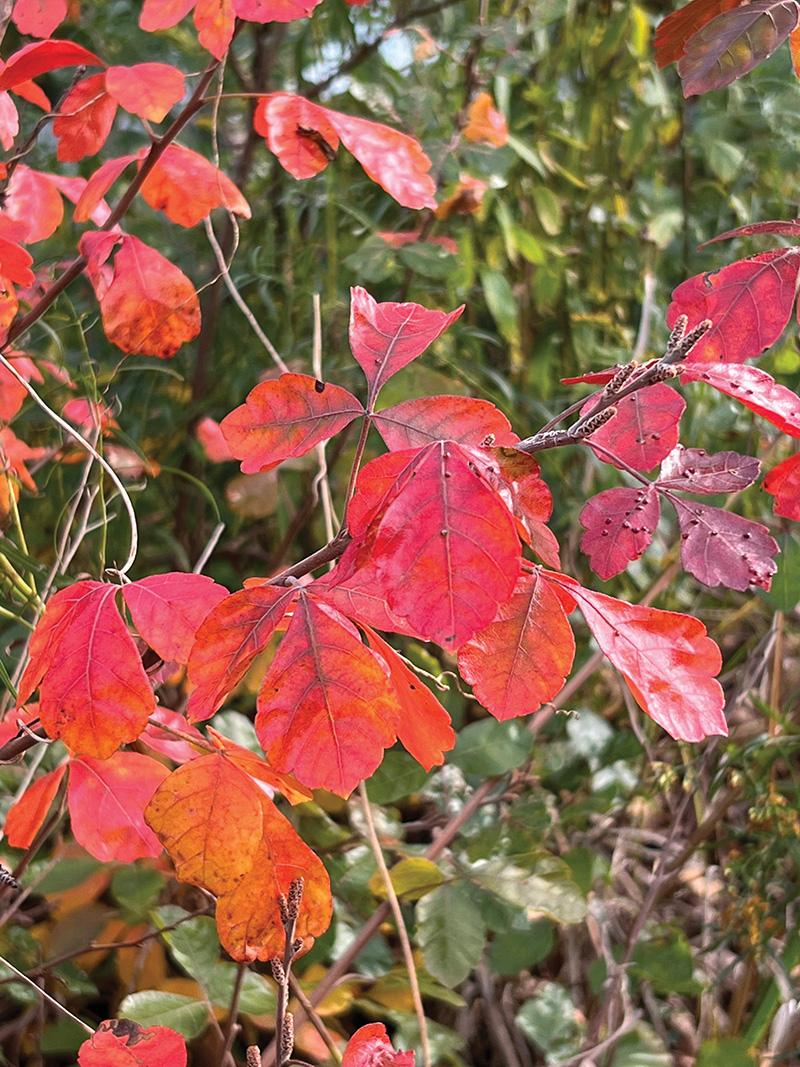
Fragrant Sumac is a low-growing shrub that has knock-out fall foliage, with zig-zagging branches that bear clusters of leaflets that turn a deep red and orange, even burgundy.
Unfortunately, finding the right native shrub can be daunting, and the offerings from the easy-to-find places, such as the local grocery store or big box hardware stores, have a limited menu, most of which are non-native and too many of which are invasive.
It’s great to see and hear about the interest in growing native plants—especially for perennials that can become a part of our increasingly rapid adoption of pollinator pathways. And while perennial plants are the backbone of our flower gardens, shrubs can also provide surprising benefits for pollinators as well as other wildlife, and once they are established, they do not need the same level of attention that our flower beds do.
We’re going to explore just a handful of native shrubs that are often overlooked, but they are exceptional and worth considering for your home or community landscape.
You should be able to find native shrubs at an established local plant nursery, and it’s a great idea to shop local if you can. If you don’t find the shrub that you’re looking for, ask your nursery to order and carry it. You can also support your local Conservation District by purchasing from their annual spring native plant sale. In the estuary region, you can find information here: www.conservect.org/ctrivercoastal. Other sources include Wild Ones, a native plants and natural landscaping nonprofit, which often collaborates with the Connecticut College Arboretum. Regionally, consult Native Plant Trust (formerly the New England Wildflower Society), and Earth Tones Native Plants nursery in Woodbury grows strictly Connecticut native plants.
Buttonbush (Cephalanthus occidentalis)
I have always associated the shrub buttonbush (Cephalanthus occidentalis) with wetlands—the banks of rivers, including along the Connecticut and its tributaries, and even growing in shallow wetlands such as vernal pools or kettle ponds. So, it was a surprise when Jessica Lubell, the “Native Plant Gal” at UConn’s Department of Plant Science and Landscape Architecture, recommended this plant for tough places—even parking lot medians—based on her experimental trials in search of rugged native plants to recommend.
This seldom-used shrub bears attractive and fragrant white-to-faintly-pink flowers through the summer months. The flowers are unusual in that they form a ball of densely-packed tiny tubes with a fringe of thin, extended spikes (actually the very long pistils). They are fragrant and attractive to a variety of insect pollinators, including butterflies and even hummingbirds—so much so that the Xerces Society for Invertebrate Conservation considers this shrub of special value to their Pollinator Program.
The flowers eventually produce attractive red fruits bearing two-seeded nutlets that will persist through the winter, making them important to birds, including waterfowl, as well as mammals.
The shrub itself is good for naturalizing, and can be shaped if desired. It grows by multiple stems, bearing glossy deep green leaves. Buttonbush will grow from six to twelve feet tall, but can be cut back near to the ground in early spring to revitalize it. A dwarf cultivar of this shrub is available called Cephalanthus occidentalis, “Sugar Shack.” It is well suited for home foundation plantings, growing three to four feet high and wide.
While the Buttonbush prefers wet and can withstand inundation up to three feet, making it good for wetland buffers and rain gardens, it is adaptable: it will tolerate anything but persistently dry soil.
Fragrant Sumac (Rhus aromatica)
Although readily available, this attractive low-growing and spreading plant is not used nearly as much as I think it should be. In addition to being without any serious pests, it is said to be tolerant of drought, erosion, black walnut (which suppresses plant competition by a chemical), rabbits, and clay, dry, and/or shallow rocky soil.
Fragrant Sumac is a low (under three feet), spreading (six to ten feet) shrub that forms thickets. Its flowers are inconspicuous, but this shrub has knock-out fall foliage, with zig-zagging branches bearing clusters of leaflets that turn a deep red and orange, even burgundy. When crushed the leaves have a lemony scent.
The female flowers produce small clusters of hairy red berries in late summer that provide food for wildlife throughout the winter, while the low-growing and dense vegetation provides cover for small mammals.
Because of its spreading habit and way of easily rooting where the stems come into contact with the soil, Fragrant Sumac is effective at stabilizing banks and slopes. It can take full sun to partial shade and accommodate moist-to-dry conditions but prefers well-drained soil.
Perhaps this plant is not used more often because it could be confused at first glance with poison ivy; it similarly has “leaves of three” and in the fall, especially, the foliage turns red as well. But nothing about this plant is poisonous.
If more of a ground cover is desired, there is a cultivar of this plant Rhus aromatica, “Gro-Low.”
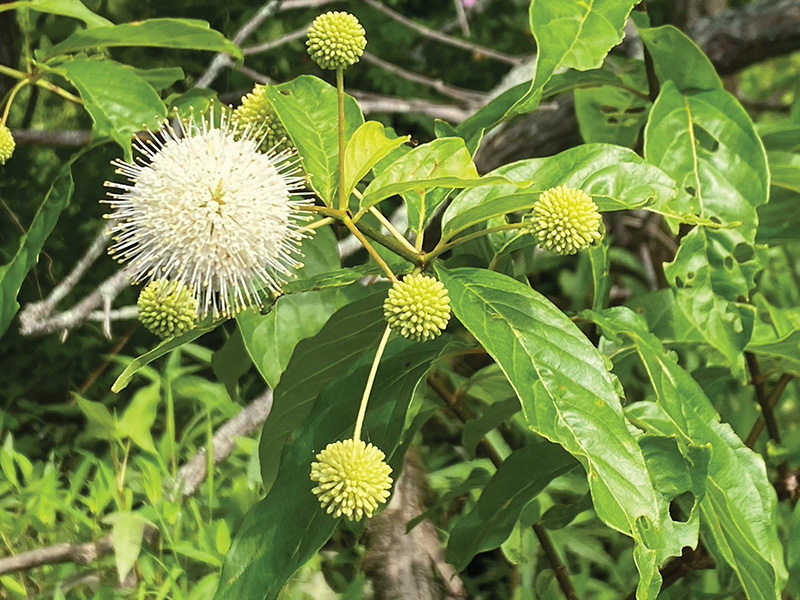
Buttonbush (Cephalanthus occidentalis)
This versatile native shrub has unusual flowers that form a fringed ball that are fragrant and attractive to a variety of insect pollinators, including butterflies and even hummingbirds.
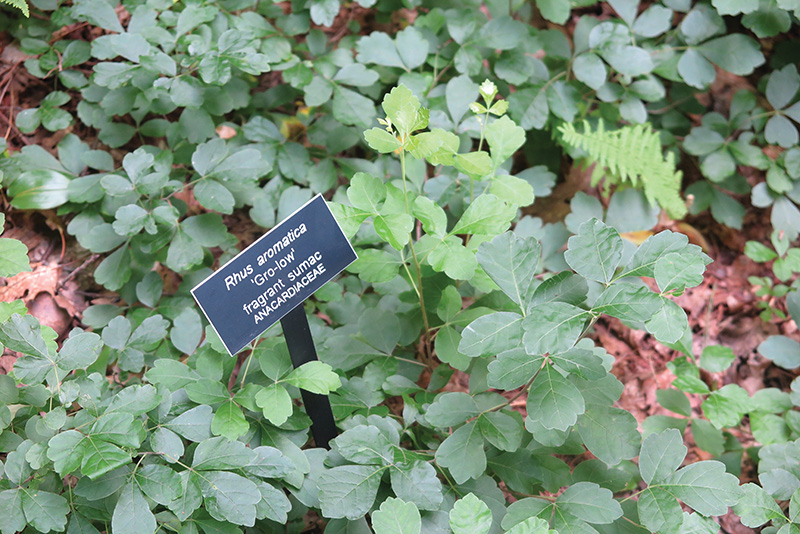
Fragrant Sumac (Rhus aromatica)
You can find this, and many other examples of native plants, at the Connecticut College arboretum. Although possibly confused with poison ivy, nothing about this plant is poisonous. When crushed the leaves have a lemony scent.
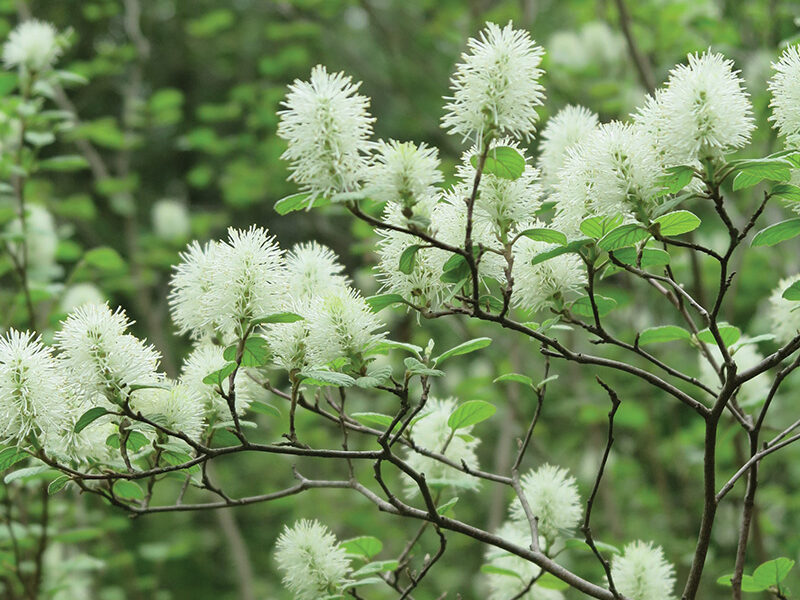
Dwarf Fothergilla (Fothergilla gardenia)
This plant has seasonal appeal: creamy bottlebrush spring flowers, frost-tolerant fall color, and a zig-zag branching habit for winter interest.
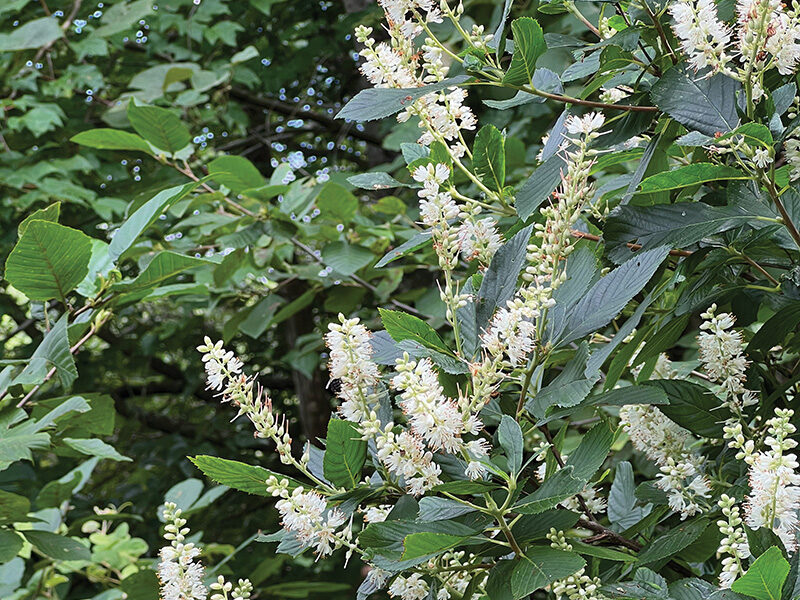
Summersweet (Clethra alnifolia)
A mystery insect has wrapped itself in Summersweet leaves, developing into likely a moth or butterfly. It’s a good reminder that native plants are essential to native insects, many of whom are pollinators.
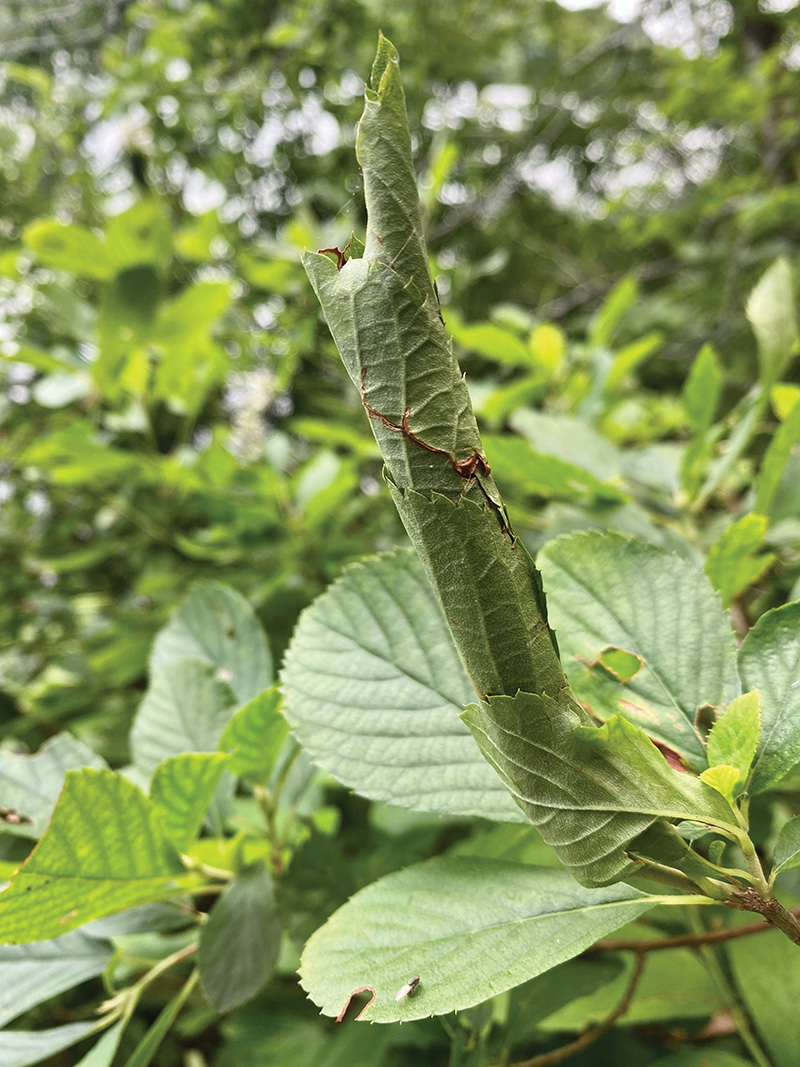
Buttonbush (Cephalanthus occidentalis)
This versatile native shrub has unusual flowers that form a fringed ball that are fragrant and attractive to a variety of insect pollinators, including butterflies and even hummingbirds.
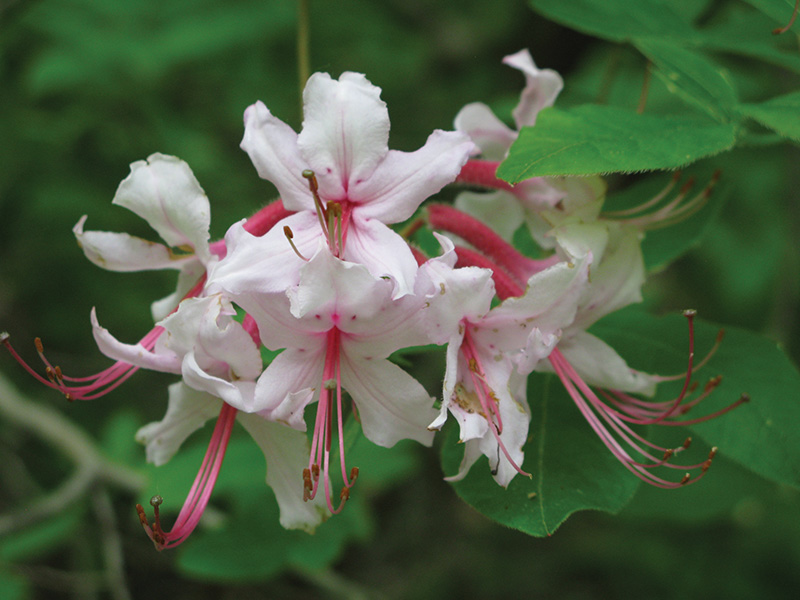
Pinxterbloom Azalea
(Rhododendron periclymenoides)
The elegant, funnel-shaped flower cluster of this native azalea is a show-stopper, attracting both hummingbirds and swallowtail butterflies.
Dwarf Fothergilla (Fothergilla gardenia)
I became curious about Dwarf Fothergilla when visiting Newport, Rhode Island, for a conference a number of years ago, where I found it as part of the landscaping in front of the hotel. It struck me as a lovely small version of my most favored Witch Hazel plant (Hamamelis virginiana). Sure enough, I eventually found its name and discovered that it is in the same family, Hamamelidaceae, and is also called the Coastal Witch-alder. Although its native range is in the southeastern part of the US, this plant has become increasingly familiar in southern New England landscaping, and with good reason.
Fothergilla gardenia has appeal throughout the seasons: creamy bottlebrush spring flowers that appear before its leaves emerge, and impressive, frost-tolerant fall color that ranges from yellow to a warm red-orange, often tinged in green. Even in the winter, this compact shrub’s zig-zag branching habit makes it a pleasing plant for winter interest. The honey-scent of this shrub makes it a pleasant addition to any landscape, in addition to attracting bees and other pollinating insects.
With a mature height of three feet (there is a larger Fothergilla major that grows to six feet), this shrub makes an attractive foundation planting. It prefers rich, moist, and well-drained soil in full sun to partial or dappled shade (doing best with some afternoon shade); it is tolerant, however, of wet, compacted soil and can be drought tolerant. To keep it from colonizing other parts of your landscape, newly emerging suckers need to be removed.
Summersweet, Sweet Pepperbush (Clethra alnifolia)
Sweet Pepperbush is common in our southern New England woodlands where it is found as an understory shrub in deciduous woodlands and along streams, also occurring along the coast where it readily accommodates the salty air. It is most often found in moist conditions with organic soils, although, similar to most native plants, once established it can tolerate a range of conditions—in this case sandy soils—and short periods of drought and flooding. It does not like consistently hot and dry conditions, however. Although it can take full sun, it prefers partial shade.
It’s a wonder why this plant isn’t used more for landscaping purposes; whether you need a thick screen to block a view or a specimen plant, Summersweet is a low maintenance shrub. It has multiple stems and grows five to nine feet. It produces suckers, forming thickets when desired, or responds well to heavy pruning. There are a number of compact cultivars, such as “Tom’s Compact,” “16 Candles,” and “Hummingbird” that make this plant suitable for foundation plantings where height is a consideration.
Combined with other native landscaping shrubs, Summersweet offers extraordinarily sweet-smelling flowers and, unlike many other shrubs that bear their blooms in spring, produces its clusters of white spike flowers in late summer, especially when grown in the shade. This is also a boon, and by late fall a dry capsule at the end of its branches will offer seed for birds during the winter.
Pinxterbloom Azalea (Rhododendron periclymenoides)
In contrast to the popular, cultivated evergreen azalea, native to Asia, our native North American azaleas have elegant, funnel-shaped flower clusters with five long, gently curved stamens that emerge from each flower. The color of the Pinxterbloom blossom varies from white to lavender, with the most common—and exquisite—a soft pink offset by deep fuchsia stamens. The flowers emerge in April or May and precede the emergence of their leaves, another striking aspect of this plant. For such a stunning plant, it surprises me that they are not more in demand.
Perhaps it’s because Azaleas are not “care-free” shrubs, although our native azalea has more resistance to the common insect and disease problems that plague the non-native species. They prefer moist conditions but don’t respond well to either overwatering or overfertilizing. They are found in their natural habitat in the understory—dappled shade in moist, well-drained, and acidic soils and protected from late afternoon sun. Although capable of growing in full sun, their preference is for that dappled light or “high, open shade.” The Pinxterbloom benefits from the use of mulch to help retain moisture and keep the soil temperature even.
Not surprisingly, with the long stamens and deep flower “throat,” the blossoms of this shrub attract both hummingbirds and swallowtail butterflies, and in the southern part of its range, it is known to host at least fifty species of native caterpillars—essential for many other wildlife species, especially birds.
The Pinxterbloom Azalea typically grows from three to six feet tall and can spread by suckering. In its natural habitat, when occurring along streams or wet edges, it can form dense thickets, although it grows slowly.
As I get older and realize how many garden beds I’ve initiated over the years, I realize that curtailing labor-intensive plants in favor of more independent ones is a very good idea. While not entirely care-free, once established, native shrubs are an excellent trade-off, providing both aesthetic and ecological pleasures and the time to enjoy them!
Judy Preston is a local ecologist active in the Connecticut River Estuary.

